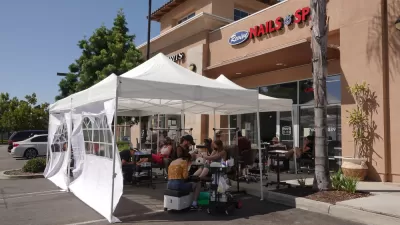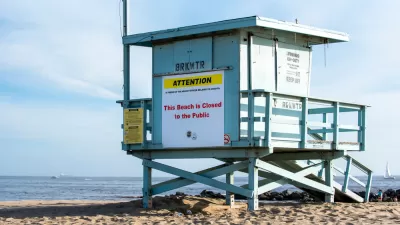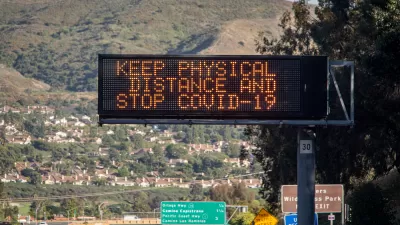With COVID infections plummeting, Gov. Gavin Newsom surprisingly lifted California's regional stay home order that had imposed the nation's strictest personal and business restrictions during the most deadly phase of the pandemic.

Even with much of the state facing oncoming storms for the week, Tuesday was a brighter day for most Californians, who can now or soon access more services and also for the businesses and their workers who will accommodate hungry diners (if protected from the rain) and residents in need of haircuts and manicures.
The state's pandemic reopening plan reverted back to the county-based Blueprint for a Safer Economy after the California Department of Public Health (CDPH) ended the Regional Stay at Home Order on Jan. 25, allowing more indoor and outdoor activities. [See "Widespread" Tier 1, aka purple tier in the blueprints "Activity and Business Tiers" (pdf).]
"Californians heard the urgent message to stay home as much as possible and accepted that challenge to slow the surge and save lives," said Dr. Tomás Aragón, CDPH director and state public health officer, in a press release (source article) announcing the lifting of the regional order and the Limited Stay at Home Order, aka curfew, which limits non-essential activities between the hours of 10 p.m. and 5 a.m.
While there are positive signs that the virus is spreading at a slower rate across the state, the COVID-19 pandemic is far from over. It is still critical that Californians continue to wear masks when they leave their homes, maintain physical distance of at least 6 feet, wash their hands frequently, avoid gatherings and mixing with other households, follow all state and local health department guidance and get the vaccine when it's their turn.
All but one of the state's five regions shut down last month due to the state's first regional, rather than county-based, reopening plan based entirely on one metric: meeting a threshold of 15% hospital intensive care unit (ICU) capacity. On Jan. 26, only the largely rural Northern California region, north of the Bay Area and Greater Sacramento regions, had ICU capacity (47.9%) exceeding that threshold. So why was the order lifted?
Projection-based metric
Rather than basing the lifting of the regional order on actually meeting the metric, the state is using projections.
Four-week ICU capacity projections for these three [San Joaquin Valley, Bay Area, and Southern California] regions are above 15%, the threshold that allows regions to exit the order. The Sacramento Region exited the order on January 12 and the Northern California region never entered the order.
[Correspondent's note: Note that the above link for ICU Projections By Region, a 4-week projection made on Jan. 24 for the week ending Feb. 21, includes two other metrics discussed here recently: case rate (daily new cases or incidence) and R-effective (infection or transmission rate).]
The press release doesn't show the actual, as opposed to projected, ICU availability metric for the four regions not meeting the threshold on Jan. 26:
-
Greater Sacramento: 9.9%
-
Bay Area: 8.2%
-
San Joaquin Valley and Southern California: both are 0.0%
Uncertainty ahead
Clearly, the key COVID metrics for the state, as well as the nation, are moving in the right direction. California no longer leads the nation in daily new cases—it's #7 with 65.3 cases per 100,000 people on Jan. 26, after Rhode Island, Arizona, South Carolina, Georgia, New York, and North Carolina, respectively, according to Covid Act Now. While much higher than the nation's average of 51 per 100k, consider where the state was last month—noted in a post last month on California's hospital crisis:
California is #2 in the nation in daily new cases, 102 per 100k, after Tennessee, 135 per 100k, while Rhode Island is third (94 per 100k) on December 20.
A second post on the hospital crisis earlier this month focused on Los Angeles:
The Los Angeles metropolitan area is #4 in "Where the Outbreak Is Worst Now" on The New York Times metro/micro area tracker on Jan. 3, at 132.2 coronavirus cases per 100,000 people. California's Inland Empire, also in Southern California, is #1 at 141.8 cases per 100k. As high as that may be, it's been higher in other metropolitan regions.
The Inland Empire is #4 on that tracker on Jan. 26 with 121 per 100k, not that significant an improvement while Los Angeles has seen more improvement, dropping to #16 with 98 cases per 100k. The Covid Act Now metro tracker on Jan. 26 shows even more improvement for the two Southern California metropolitan regions:
-
Riverside: #5 with 105 cases per 100k and 0.87 infection rate
-
Los Angeles: #39 with 75.5 cases per 100k and 0.79 infection rate
While the metrics have improved, the hospital crisis in Southern California is still critical, report Rong-Gong Lin II and Luke Money for the Los Angeles Times on Jan. 20.
Despite some promising signs that the worst wave of the COVID-19 pandemic may finally be receding, a top Los Angeles County health official warned Wednesday that the situation remains precarious, with thousands of more people becoming infected every day and an unsustainable number of patients requiring hospital treatment.
Even if the decrease is legitimate, officials said it’s only a fraction of what’s needed to relieve the stress on overwhelmed hospitals and overworked healthcare staff. As county Public Health Director Barbara Ferrer noted, “With high numbers of daily cases, hundreds more people will require hospitalization every week.”
Criticism
The editorial boards of The Mercury News and East Bay Times held no punches in their stinging criticism of the governor's decision.
The governor’s irresponsible action Monday is the latest in a series of blunders that is severely damaging California’s ability to end the COVID-19 crisis.
The drop in the number of coronavirus cases over the weekend is good news, but the overall outlook hardly justifies opening up businesses and activities. That approach has only led to ensuing surges that further cripple the state.
The editorial is fraught with data indicating the lifting of the order is premature, although they admit that the trends are going in the right direction. And then there are the coronavirus variants that increase transmission. They end by writing:
Newsom should be extending the stay-at-home orders rather than ending them altogether. Instead, he is repeating a strategy that has done next to nothing to bring the COVID crisis to an end.
Time will tell. The pandemic is anything but stagnant. Gov. Newsom saw what happened when he first reopened the economy in May after the initial surge. He overhauled the reopening plan, unveiling the current blueprint on Aug. 28 which had proven successful until the fall and winter holidays.
Additional reading on the lifting of restrictions can be found in the San Francisco Chronicle, Los Angeles Times, Southern California News Group, and The New York Times.
Related in Planetizen:
-
California Hospitals Now Operating Under Contingency Care Guidelines, January 4, 2021
-
California's Hospital Crisis: What Lies Ahead, December 21, 2020
-
California Rolls Back, July 14, 2020
-
The Rush to Open: California is No Exception, May 7, 2020
FULL STORY: Public Health Officials Lift Regional Stay at Home Order for All Regions

Study: Maui’s Plan to Convert Vacation Rentals to Long-Term Housing Could Cause Nearly $1 Billion Economic Loss
The plan would reduce visitor accommodation by 25% resulting in 1,900 jobs lost.

Alabama: Trump Terminates Settlements for Black Communities Harmed By Raw Sewage
Trump deemed the landmark civil rights agreement “illegal DEI and environmental justice policy.”

Why Should We Subsidize Public Transportation?
Many public transit agencies face financial stress due to rising costs, declining fare revenue, and declining subsidies. Transit advocates must provide a strong business case for increasing public transit funding.

Paris Bike Boom Leads to Steep Drop in Air Pollution
The French city’s air quality has improved dramatically in the past 20 years, coinciding with a growth in cycling.

Why Housing Costs More to Build in California Than in Texas
Hard costs like labor and materials combined with ‘soft’ costs such as permitting make building in the San Francisco Bay Area almost three times as costly as in Texas cities.

San Diego County Sees a Rise in Urban Coyotes
San Diego County experiences a rise in urban coyotes, as sightings become prevalent throughout its urban neighbourhoods and surrounding areas.
Urban Design for Planners 1: Software Tools
This six-course series explores essential urban design concepts using open source software and equips planners with the tools they need to participate fully in the urban design process.
Planning for Universal Design
Learn the tools for implementing Universal Design in planning regulations.
Smith Gee Studio
Alamo Area Metropolitan Planning Organization
City of Santa Clarita
Institute for Housing and Urban Development Studies (IHS)
City of Grandview
Harvard GSD Executive Education
Toledo-Lucas County Plan Commissions
Salt Lake City
NYU Wagner Graduate School of Public Service





























